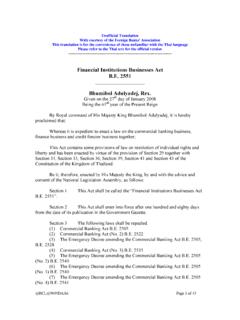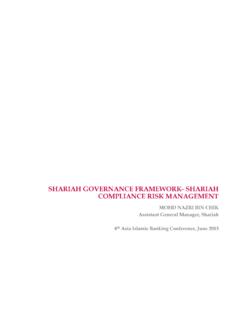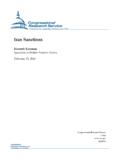Transcription of Managing Risks of Electronic Banking, Direct Debit …
1 Issued on: 24 December 2014 Managing Risks of Electronic banking , Direct Debit and Risks associated with Payment instruments Circular BNM/RH/CIR 028-6 Payment Systems Policy Department Consumer and Market Conduct Department Managing Risks of Electronic banking , Direct Debit and Risks associated with Payment instruments 1. INTRODUCTION .. 1 2. APPLICABILITY .. 2 3. ISSUANCE AND EFFECTIVE DATE .. 3 4. INTERPRETATION .. 3 5. SUPERVISORY EXPECTATIONS .. 5 BNM/RH/CIR 028-6 Payment Systems Policy Department Consumer and Market Conduct Department Managing Risks of Electronic banking , Direct Debit and Risks associated with Payment instruments Page 1/11 1. INTRODUCTION Electronic banking As provided in the Guidelines on the Provision of Electronic banking (e- banking ) Services by Financial Institutions (FIs) issued on 30 March 2010, the board of directors and senior management of FIs are responsible to address the Risks associated with the security, integrity and availability of the FIs e- banking products and services.
2 In this regard, FIs amongst others, should continuously assess the effectiveness of their risk mitigation measures and take proactive measures on a timely basis in addressing new security threats that may result in financial losses to the FIs and their customers, and would undermine customer confidence and the FIs reputation. The recent cases of malware attacks on internet banking customers accounts where fraudsters have been able to steal confidential banking information such as the victim s login credentials, password and transaction authentication code is a concern. As new malware virus variants are introduced, anti-virus software are likely to lag behind, thus undermining the effectiveness of using mobile devices for the purpose of second factor authentication of internet banking transactions.
3 Consequently, there is a need for FIs and issuers of designated payment instruments to review the adequacy of their second factor authentication method. Direct Debit The exposure of customers account details ( bank account details or designated payment instrument account details) may increase the risk of such information being misused to create unauthorised Direct Debit transactions. with the increasing use of Electronic payments , it is important to further strengthen the risk mitigation measures to counter any misuse of customers account details. BNM/RH/CIR 028-6 Payment Systems Policy Department Consumer and Market Conduct Department Managing Risks of Electronic banking , Direct Debit and Risks associated with Payment instruments Page 2/11 Card-not-present and overseas transactions for designated payment instruments with the growth of Debit and prepaid cards that allow consumers to conduct face-to-face (card present) transactions both locally and abroad, as well as, non-face-to-face (card-not-present) transactions, there is a need to implement adequate risk management measures and controls, and to educate customers of the safe practices in order to mitigate the Risks of unauthorised transactions, in particular for card-not-present and overseas transactions.
4 Customer Confidence Following the recent cases of malware attacks, it is important to enhance the protection of consumers and strengthen consumer confidence by clearly stating the circumstances in which customers can be held liable for unauthorised transactions and facilitating the efficient resolution of disputed transactions. In addition, with the anticipated growth in Electronic payment transactions and increase in the usage of payment cards, particularly the Debit card, FIs and issuers should take proactive measures to ensure that their risk mitigation mechanisms remain effective to safeguard their customers account balances. The requirements in this Circular are in addition to the consumer protection measures provided in the Guidelines on the Provision of E- banking Services by Financial Institutions, Guidelines on Complaints Handling and the policy documents on credit card/credit card-i, charge card/charge card-i and Debit card/ Debit card-i.
5 2. APPLICABILITY This Circular is applicable to all FIs and issuers of designated payment instruments . BNM/RH/CIR 028-6 Payment Systems Policy Department Consumer and Market Conduct Department Managing Risks of Electronic banking , Direct Debit and Risks associated with Payment instruments Page 3/11 Except for paragraphs to , the requirements in this Circular shall apply to transactions performed by individuals, micro and small enterprises. The requirements under paragraphs to are applicable to e- banking transactions, Direct Debit transactions and card-not-present transactions using designated payment instruments , as the case may be. The requirements under paragraphs to are applicable to card-not-present and overseas transactions using Debit card, Debit card-i and prepaid card.
6 The requirements under paragraphs to are applicable to financial products and services where funds are drawn from customers savings, current or prepaid account balances. 3. ISSUANCE AND EFFECTIVE DATE Unless otherwise stated, the requirements in this Circular come into effect on: (a) 2 February 2015 with respect to all the requirements except the requirements set out in paragraphs and below; and (b) 1 June 2015 with respect to the requirements set out in paragraphs and below. 4. INTERPRETATION For the purpose of this Circular: e- banking means the provision of banking products and services through Electronic channels, including via the internet, mobile devices, telephone, automated teller machines (ATM), and any other Electronic channel. financial institution or FI means any person licensed under the Financial Services Act 2013 (FSA) or the Islamic Financial Services Act BNM/RH/CIR 028-6 Payment Systems Policy Department Consumer and Market Conduct Department Managing Risks of Electronic banking , Direct Debit and Risks associated with Payment instruments Page 4/11 2013 (IFSA) or prescribed under the Development Financial Institutions Act 2002 (DFIA).
7 Issuer of designated payment instrument or issuer means any person who has obtained approval from Bank Negara Malaysia (BNM) under the FSA or the IFSA to issue a designated payment instrument. Direct Debit means a payment service for debiting a payer s account ( savings account, current account or designated payment instrument account) whereby a payment transaction is initiated by the payee on the basis of consent given by the payer to: (a) the payee; (b) the payee s FI or issuer of designated payment instrument; or (c) the payer s own FI or issuer of designated payment instrument. designated payment instrument means any or all of the following payment instruments prescribed as designated payment instruments under the FSA or designated Islamic payment instruments under the IFSA: (a) Credit card / credit card-i; (b) Charge card / charge card-i; or (c) Debit card / Debit card-i; or (d) Electronic money and for the purpose of this Circular, the term Electronic money shall mean a prepaid card as defined below.
8 Micro and small enterprises has the same meaning as defined in the Circular on New Definition of Small and Medium Enterprises (SMEs) issued by BNM. pass code means a password or code that is used to authenticate the identity of a customer and to authorise a transaction. A pass code may consist of numbers, letters, a combination of both, or a phrase. Examples of passcode include: (a) password; BNM/RH/CIR 028-6 Payment Systems Policy Department Consumer and Market Conduct Department Managing Risks of Electronic banking , Direct Debit and Risks associated with Payment instruments Page 5/11 (b) one-time password (OTP) (c) personal identification number (PIN); and (d) code generated by a security device. payment instrument means any instrument, whether tangible or intangible, that enables a person to obtain money, goods or services or to make any payment.
9 Prepaid card means Electronic money stored in a host system or in a card which can be used to conduct card-present transactions both locally and abroad, as well as, card-not-present transactions. security device means a token or other device that generates a pass code. 5. SUPERVISORY EXPECTATIONS E- banking transactions, Direct Debit transactions and card-not-present transactions made using designated payment instrument FIs and issuers must take reasonable steps to ensure that customers are adequately alerted and provided with updated safety tips that are practicable and effective, including but not limited to the obligations set out in paragraphs (b) and (b) below, in order to prevent customers from becoming victims of e- banking , Direct Debit and card-not-present fraud. A FI must ensure that a customer shall not be held liable for losses arising from an e- banking transaction unless the FI can prove on a balance of probabilities that: (a) The customer has acted fraudulently; or (b) The customer has failed to carry out the following obligations as informed by the FI to the customer: (i) Not deliberately disclosing the access identity (ID) and passcode to any other person, via unsolicited emails or on any BNM/RH/CIR 028-6 Payment Systems Policy Department Consumer and Market Conduct Department Managing Risks of Electronic banking , Direct Debit and Risks associated with Payment instruments Page 6/11 website other than the official website of the FI; (ii) Taking reasonable steps to keep security device secure at all times.
10 Or (iii) Reporting a breach of the security of a pass code or the loss of a security device to the FI as soon as reasonably practicable, upon the customer becoming aware of the breach or loss respectively. A FI or an issuer must ensure that a customer shall not be held liable for losses incurred from a Direct Debit transaction or a card-not-present transaction unless the FI or the issuer, as the case may be, can prove on a balance of probabilities that: (a) The customer has acted fraudulently; or (b) The customer has failed to carry out the obligation to report any unauthorised transaction to the FI or the issuer as soon as reasonably practicable, upon the customer becoming aware of the unauthorised transaction. Provided that a customer has not acted fraudulently, a FI or an issuer must ensure that the customer shall not be held liable for losses incurred from an e- banking , Direct Debit or card-not-present transaction if the cause of the losses is due to any of the following: (a) The FI or the issuer concerned has failed to take reasonable steps to provide adequate and conspicuous reminders of the obligations that the customer should undertake as stated in paragraph (b) or paragraph (b) above; (b) The FI or the issuer concerned has failed to provide adequate means for the customer to notify the FI or the issuer of the unauthorised transaction; (c) A technical breakdown or some other deficiency in the systems or equipment of the FI or the issuer.















